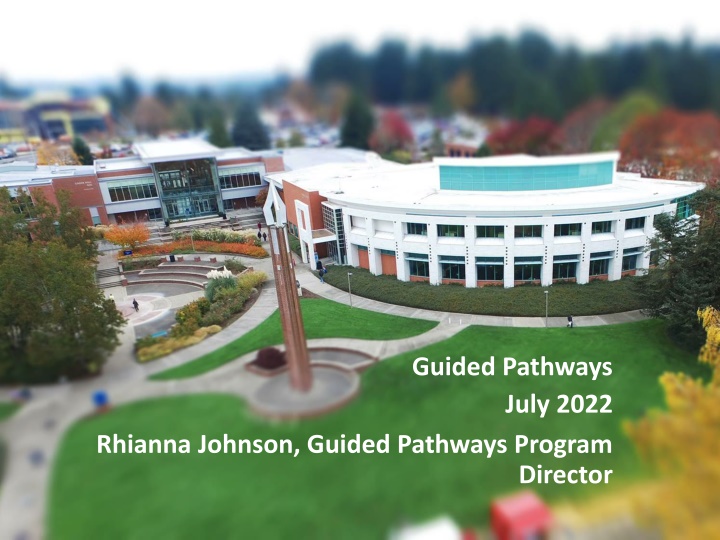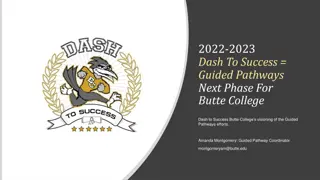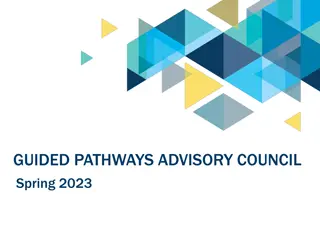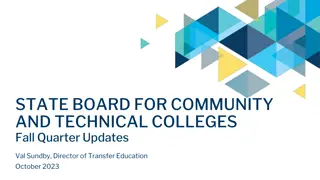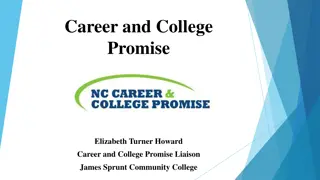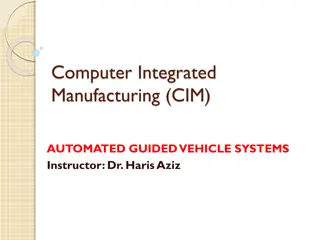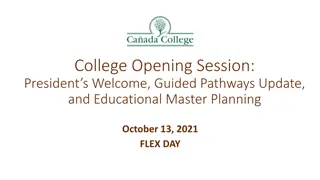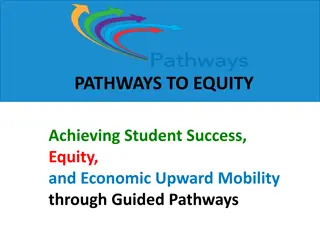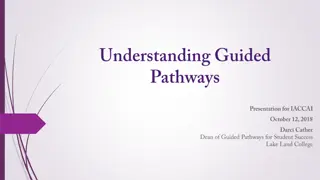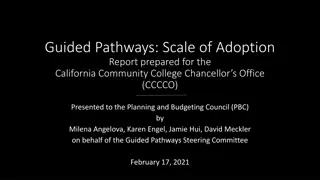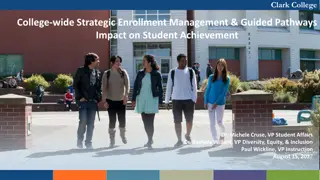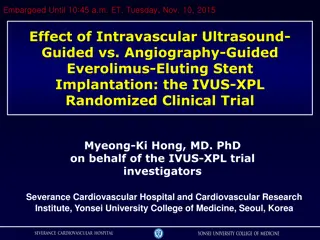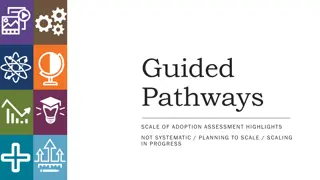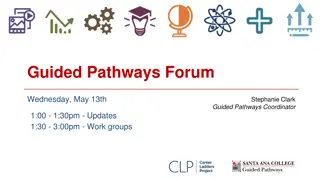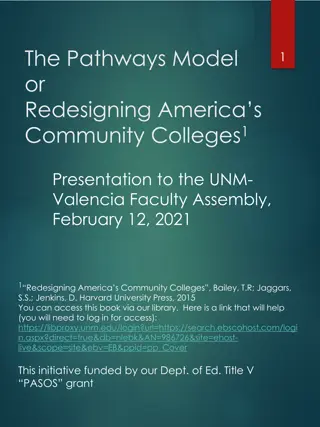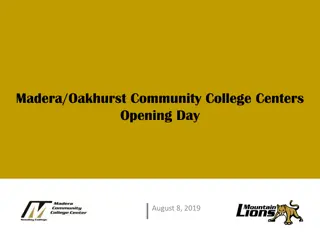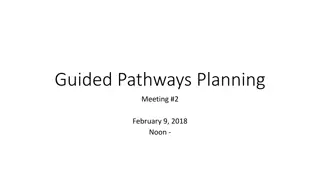21-22 Guided Pathways Highlights
Development and implementation of the Comprehensive Guided Pathways plan at Clark College for 2022-2024, focusing on improving student success outcomes, enrollment rates, retention, and reducing equity gaps. The plan includes activities such as faculty, staff, and student participation in retreats, project tracking, budget proposal processes, and the reestablishment of the Guided Pathways Advisory Council. Collaboration across various campus constituencies to align Guided Pathways with Strategic Enrollment Management (SEM) goals and enhance the student experience.
Download Presentation

Please find below an Image/Link to download the presentation.
The content on the website is provided AS IS for your information and personal use only. It may not be sold, licensed, or shared on other websites without obtaining consent from the author.If you encounter any issues during the download, it is possible that the publisher has removed the file from their server.
You are allowed to download the files provided on this website for personal or commercial use, subject to the condition that they are used lawfully. All files are the property of their respective owners.
The content on the website is provided AS IS for your information and personal use only. It may not be sold, licensed, or shared on other websites without obtaining consent from the author.
E N D
Presentation Transcript
Guided Pathways July 2022 Rhianna Johnson, Guided Pathways Program Director
Rashida Willard 21-22 Guided Pathways Highlights Director hired to provide administrative support and leadership Comprehensive Guided Pathways plan was developed collaboratively and submitted to SBCTC to cover 2022-2024 focus areas and activities Alignment of Guided Pathways plan with SEM plan Several faculty, staff and students attended SBCTC Guided Pathways retreats and work sessions, producing valuable insights and feedback
Rashida Willard 21-22 Guided Pathways Highlights, SEM + GP Alignment Generate knowledge of pathways Increase CTC and CCW enrollment by 5% Clarify the path Increase prospect pool and conversions Enter the path Increase overall enrollment by 5% Stay on the path Increase fall to fall retention by 10% Support learning Reduce equity gap by 50% Intentional assessment and ongoing review Improve student success outcomes by 5%
Rashida Willard 21-22 Guided Pathways Highlights (continued) Information about Guided Pathways activities and direction was shared in multiple spaces including LEAD, IC, Student Affairs, EC, GPAC and BOT meetings Teams collaborated to create a project tracking plan to operationalize focus areas of the 22-24 state plan A new budget project proposal process was instituted to allow campus stakeholders an opportunity to clearly articulate Guided Pathways ideas and initiatives for 22-23 Over 30 proposals received in multiple functional areas
Rashida Willard 21-22 Guided Pathways Highlights (continued) The Guided Pathways Advisory Council was reestablished with a new group charter, including a member of the Board of Trustees New Guided Pathways informational materials were developed and shared with campus constituencies, including a new shared document repository Another year of coaching was completed with positive feedback about the direction of Guided Pathways at Clark College Student consultants participated in multiple GP projects and the winter retreat
Rashida Willard An advisory council to inform the priorities of Guided Pathways at Clark College to ensure equitable strategies and initiatives that align with Senate Bill 5194. Purpose Statement Purpose Statement Bring forward ideas and areas of focus from departments Provide recommendations regarding budget priorities Serve as a Guided Pathways ambassador and proponent at the department level Promote equity centered strategies and initiatives Mission and Objectives Mission and Objectives Guided Pathways Advisory Council Cross-section of the college (Instruction, AIR, Student Affairs, Communications and Marketing) Team Members Team Members Campus faculty and staff External workforce development partners K-12 partners Students Stakeholder Groups Stakeholder Groups Written proposals and ideas Meeting Deliverables Meeting Deliverables Operational Details Operational Details Initial kick-off retreat Review of last year and current status Meets monthly for 2 hours (large group and small groups) Capstone project? Ideas, suggestions, recommendations In Scope In Scope Out of Scope Out of Scope Final budget approval
Rashida Willard Themes from GPAC, retreats, coaching and reports Great progress made this year Several documents and materials created to guide students; work remains to ensure students can navigate information systems Addressing the "fire hose" method Focus on equity and eliminating gaps, meaningful connections and sense of belonging Need to adapt to changing workforce landscape and student needs Need to have more prominent presence in the community related to career pathways
Rashida Willard Themes from GPAC, retreats, coaching and reports Most participants indicated that Clark is in the upper left or bottom right Desire to eliminate continued siloes Continued desire to utilize disaggregated data for strategic planning purposes
Rashida Willard 21-22 SBCTC Guided Pathways Plan Student Experience Intake Equity Competent Ed Planning Math and English - Year One Progress Monitoring Student Engagement/Completion Classroom Environment/Course Design Pathway Design Pathways/Program Maps Outcomes Alignment Structured Exploratory Experience Predictive Courses Math Pathways Scheduling *Work also continued in several areas outside of those targeted for the plan
Rashida Willard 21-22 SBCTC Guided Pathways Plan Focus Areas Outcomes Alignment: Course outcomes are aligned with program and pathway outcomes, and those learning outcomes inform a default course taking framework. Scheduling: Schedules are consistent and predictable and are organized in a way that makes it possible for a full-time student to complete a two-year degree in two years. Courses are scheduled to ensure students are able to enroll in the courses they need when they need them and can plan their lives around school from one term to the next (considering course conflicts, complementary and toxic course combinations, etc.).
21-22 SBCTC Guided Pathways Plan Focus Areas Intake: Every new credential seeking student is provided structured exploratory experiences (through orientation, entry advising, college success course, ethnographic experience, etc.) informed by labor market information and designed to support their choice of a pathway upon enrollment and confirm a major within the first two quarters. Orientation and intake activities are mandatory and designed to build a sense of belonging, clarify student career and college goals, and to create a comprehensive individual education and financial plan based on program/degree maps. Rashida Willard Student Engagement/Completion: The college identifies when students are losing momentum in progress toward completion and has communication tools, policies and supports in place to work with students to address their identified barriers.
Outcomes Alignment Year-End Accomplishments High level Microsoft Power BI data dashboards established Several department level data dashboards created HEDS survey completed Development and maturation of Clark College program outcome assessment and support of the Equity-Based Strategic Plan and the Strategic Enrollment Plan Reengagement with EMSI data including plans for impact reports, employment outlook, alumni outcomes, and program gap demand analysis Rapid Insight software purchased
Outcomes Alignment Year-End Accomplishments Power BI data dashboard
Scheduling Year-End Accomplishments Academic Advising Reports completed, vetted, and available for use (with ongoing fixes as needed) OER group was established, including discussions around designating OER courses in the schedule. Professional development around OER "backward course design," SBCTC OER 101, and virtual conference to learn and share information about OER best practices. Multiple discussions regarding the process of aligning catalog, AARs, advising worksheets and other educational planning materials Improved process flow for course and program changes to ensure information is communicated amongst all departments
Scheduling Year-End Accomplishments-Academic Advising Reports
Intake Year-End Accomplishments Nearly 2,000 students served at the One-Stop location Video assets developed to highlight Areas of Study, healthcare programs, AoS Success Coaching program and student explainer videos including Running Start Developed new Areas of Study webpage templates to provide better access to information about programs at Clark College, improved user experience, and connection to contact forms Communications and Marketing increased presence in the virtual Columbian space and completed marketing and outreach projects related to systemically excluded student groups
Dr. Cruse Intake Year-End Accomplishments https://www.clark.edu/aca demics/programs/public- service-society-and- education/index.php
Dr. Cruse Intake (continued) Year-End Accomplishments Adding a new credentials evaluator improved timely evaluation of incoming transcripts, resulting in 1 week turn-around time Supported Adult Reengagement activities planned for the 22-23 academic year through accurate and timely assessment of credits, coursework, life experience in Academic Credit for Prior Learning and other non- traditional credit options Guided Pathways funded ctcLink analysts in Credentials and Financial Aid to provide structural support for intake functions
Dr. Howard Engaging Students in Support of Completion Year-End Accomplishments Glean notetaking tool was added to resource suite in Disability Support Services Project completed to provide more accessibility and universal design in BIOL&100 Nearly 60 students recruited for STEM pathway camp Project completed to identify skills and outcomes for a new Clean Energy and Advanced Manufacturing degree pathway PPI coursework and/or outcomes have been embedded into all degree programs except three AAT degrees in health occupations, which will be addressed next year Coll 101 outcomes have been embedded into all programs except ACED and ECE AAS and those will be addressed next year
Rashida Willard STEM Camp
Dr. Howard Engaging Students in Support of Completion (continued) Year-End Accomplishments MESA program provided financial assistance for participants related to school costs and also emergency needs MESA students obtained internships and reported increased success skills after receiving mentoring in topics such as time management, communication, social connections, and assignment planning Over 60 students received AoS Success Coaching services and data tracking tools were established to report on program outcomes. Students reported increased efficacy as a result of meeting with coaches. The DSS pilot mentoring program indicated that students reported improved sense of belonging and course success strategies
Areas of Study Success Coaching This slide contains a visual representation of data that describes activity in the Areas of Study Success Coaching Program
Dr Howard Math and English in Year One Most students (including basic skills/ transitional studies students) earn pathway/ program appropriate college- level English and degree math credit within one year of enrollment (for part time students, within 45 credits). Year-End Accomplishments Math and English utilized Guided Pathways funds to continue to develop alternative placement processes to reduce time to completion and enhance high school placement matrices PPI curriculum and learning communities were developed in multiple departments Trainings around culturally relevant pedagogy and corequisite course designs took place throughout the year English department instituted required trainings for all instructors in ENGL& 101 Creative writing pathways and articulations were developed Project completed to develop corequisite math courses in Math 107, and Math 146; course practices revised for equity in Math 110 and 104
Dr Howard Focus on Power, Privilege, Inequity and Culturally Relevant Pedagogy Year-End Accomplishments HPE department example of PPI and culturally relevant course practices: HPE CSTL praxis plan 2.0 - examples split by instructor.pdf
Rashida Willard Professional Development & Partnerships Year-End Accomplishments High-Wage, In-Demand "mini-conference" held on May 3rd, highlighting MESA, Business, Health and Info Management, Education, Engineering, Network Technology, Surveying & Geomatics, and Welding Health Occupations completed the crisis scene simulation video to highlight career pathways in the industry and included several student actors and consultants Focus group sessions were held to gain insight about perceptions of Clark College in the community 25 staff and faculty attended NCORE conference Level Up program developed to provide systemically excluded students an opportunity to refresh math skills and gain exposure to Clark via Coll 101 content
Rashida Willard Professional Development & Partnerships Year-End Accomplishments
Rashida Willard 22-23 Focus Areas Retention=Stay on the Path 22-23 SBCTC Work Plan Focus Areas Programs of Study (clustered into Pathways) are well-designed with clearly defined learning outcomes aligned with industry identified needs and transfer pathways and are clearly mapped to guide and prepare students to enter employment and/or further education regardless of point of entry and course load. Students know which courses they should take when, are directed to default course selections designed to lead to on time completion and are able to customize their academic plans by working with an adviser or faculty member to address their individual context.
Rashida Willard 22-23 Focus Areas Retention=Stay on the Path 22-23 SBCTC Work Plan Focus Areas Classroom Environment and Course Design-Faculty are active partners in improving student success. Faculty provide meaningful and equitable learning experiences for all students and assess whether course design is resulting in student mastery of outcomes without disparities by race or gender. The college uses disaggregated student course outcomes data in addition to regular feedback from faculty and students to support focused professional development opportunities designed to improve instruction, course design, pedagogy, and assessment.
Rashida Willard 22-23 Focus Areas Budget Requests New inclusive process Examples of projects proposals: B.S. Computer Science and Clean Energy program development Support for Disability Support Services Lo Que Sigue, Level Up, MESA mentoring, STEM camp AIR support for data needs OER development and TLC improvements Equity speaker series Funding support for Communications and Marketing
Rashida Willard 22-23 Focus Areas State Plan Project Breakdown Collaborative process including GPAC, deans and directors Examples of projects: Adding EMSI data to program map pages Developing an outcomes rubric for Student Affairs services Revitalizing the TLC Increasing professional development for faculty Increasing work-based learning exploration and activities
Rashida Willard Questions, comments, feedback? Contact: Rhianna Johnson, rjohnson@clark.edu
